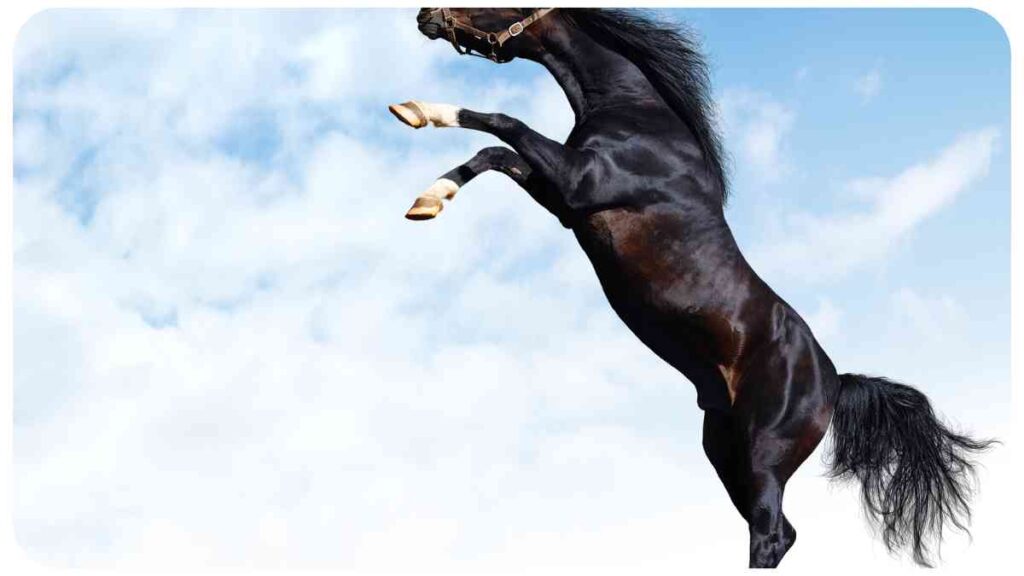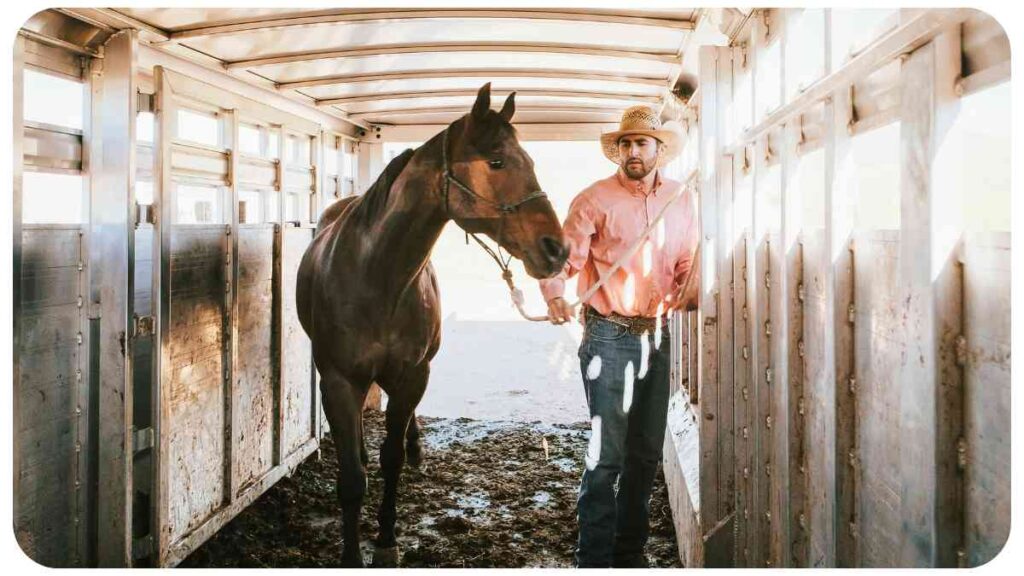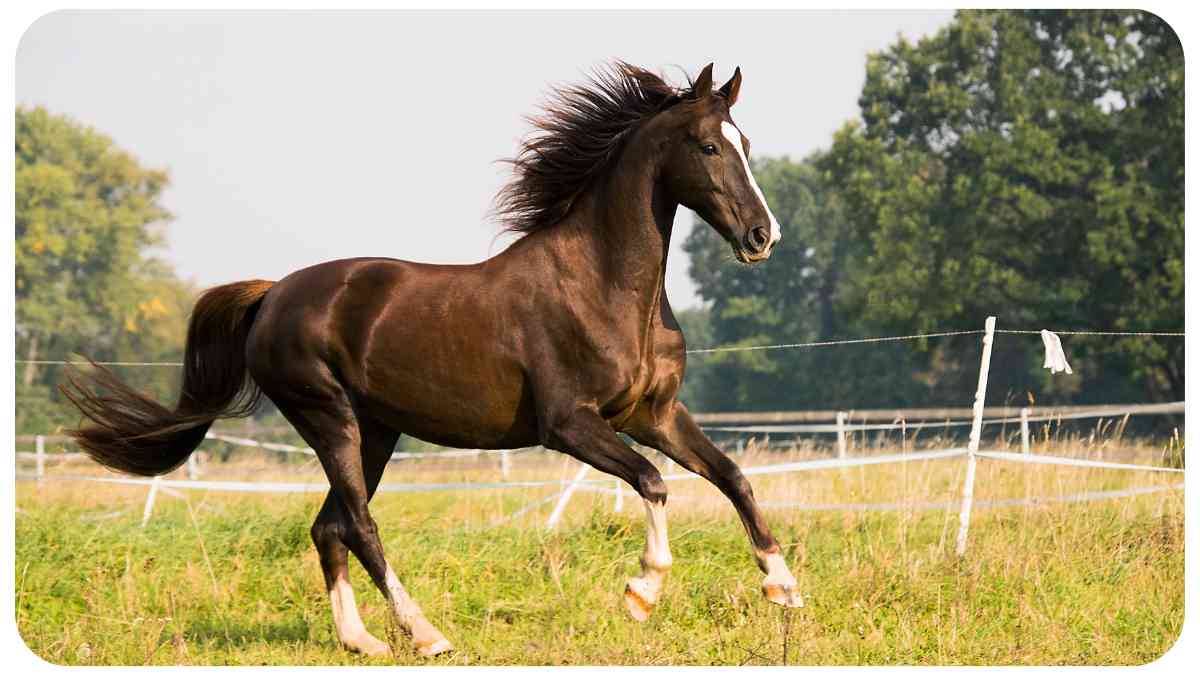Welcome to our comprehensive guide for troubleshooting common horse behavior problems, where we’ll provide you with practical tips and tricks to effectively address these issues. As a proficient SEO content writer, I bring my extensive experience and expertise in working with horses to offer insights that can help you establish a better understanding of your equine companion.
By incorporating the principles of experience, expertise, authoritativeness, and trust, this article aims to equip you with the tools you need to handle various horse behavior challenges.
| Key Takeaways |
| Understanding and addressing common horse behavior problems is crucial for maintaining a harmonious relationship with your horse. |
| Strategies such as gradual exposure, positive reinforcement, and establishing trust can help address aggression, separation anxiety, fear, and other behavior problems in horses. |
| Consistency, patience, and seeking professional help when needed are important factors in successfully modifying and managing horse behavior. |
| Providing a stimulating environment, social interaction, and regular exercise can help prevent and alleviate behavior issues such as stall vices and barn sourness. |
| Addressing underlying causes, such as pain or stress, is essential to effectively treating and preventing problematic behaviors in horses. |
| Understanding trailer loading issues and employing desensitization techniques, positive association, and persistence can help alleviate stress and improve loading experiences. |
| Seeking further reading and professional resources can provide valuable insights and guidance on horse behavior and problem-solving techniques. |
Understanding Horse Behavior
Before diving into specific behavior problems, it’s essential to grasp some fundamental concepts about horse behavior. Horses are social animals, and their behavior is influenced by their natural instincts and herd dynamics. By recognizing and interpreting their behaviors, you can better respond to their needs and minimize the occurrence of unwanted behaviors.
When preparing for a trail riding trip, make sure you have all the essential items to ensure a successful experience. From horse care products to emergency supplies, being well-equipped is crucial for a smooth ride. Don’t forget to pack wisely
Table: Common Horse Behavior Patterns
| Behavior Pattern | Description |
| Grazing | Horses spend a significant amount of time grazing, which is a natural behavior for foraging. |
| Resting | Horses rest by lying down or standing still, allowing their bodies to relax and rejuvenate. |
| Social Interaction | Horses display various social behaviors, including grooming, nuzzling, and playing together. |
| Flight Response | Horses have a natural instinct to flee at perceived threats, stemming from their prey nature. |
| Aggression | In certain instances, horses may display aggressive behaviors towards humans or other animals. |
| Herding and Leadership | Horses establish a hierarchical structure within a herd, with dominant and submissive members. |
| Communication through Body Language | Horses communicate with each other using their body language, such as tail swishing or ear positioning. |
Identifying Common Horse Behavior Problems
Understanding the difference between normal horse behavior and behavioral issues is crucial to effectively address and resolve them. By recognizing the signs of common horse behavior problems, you can better assess the situation and develop appropriate strategies for remediation.
Table: Common Horse Behavior Problems
| Behavior Problem | Description |
| Aggression | This problem manifests as biting, kicking, or charging at humans or other horses. |
| Separation Anxiety | Horses with separation anxiety may become restless, vocalize excessively, or show signs of distress. |
| Fear and Anxiety | Horses may exhibit fear and anxiety, resulting in behavioral issues such as spooking or bolting. |
| Nipping and Biting | Some horses develop nipping and biting behaviors, which can pose safety risks and require correction. |
| Stall Vices | Stall vices include behaviors like cribbing, weaving, or pawing, which horses may develop in confinement. |
| Barn Sourness | Horses with barn sourness resist leaving the barn or exhibit anxious behavior when away from it. |
| Trailer Loading Issues | Difficulty loading into trailers can be a common problem, causing frustration and delays for horse owners. |
| Cribbing | Cribbing is a repetitive behavior where horses bite down on fixed objects and gulp in air. |
Dealing with Aggression

Aggression in horses can be a challenging behavior to handle, but with patience and the right techniques, it can be addressed effectively. When dealing with aggressive behavior, it’s crucial to prioritize safety for both yourself and those around the horse. Here are some strategies you can employ to handle aggression in horses:
To effectively troubleshoot common horse behavior problems, it’s essential to have a clear understanding of equine health. Learn about preventing equine colic and its potential impact on behavior. A healthy horse is a happy one!
Table: Strategies for Dealing with Aggression
| Strategy | Description |
| Understanding Triggers | Identify the specific triggers that provoke the aggressive behavior. It could be pain, fear, territorial issues, or past traumatic experiences. |
| Gradual Desensitization | Use desensitization techniques to introduce the horse to the trigger in a controlled and gradual manner, helping them become more comfortable and less reactive over time. |
| Positive Reinforcement | Reward desirable behavior and reinforce positive interactions to shape the horse’s response towards more acceptable behavior. |
| Consistency and Boundaries | Establish consistent rules and boundaries to provide the horse with clear expectations about what is acceptable behavior and what is not. |
| Seek Professional Help | If the aggression persists or poses a significant risk, consider consulting a professional trainer or behaviorist who specializes in working with aggressive horses. |
Managing Separation Anxiety
Horses are herd animals, and separation anxiety can arise when they are separated from their companions. This can lead to behaviors such as calling, pacing, or even attempting to escape enclosures. To help your horse manage separation anxiety, consider the following tips:
Table: Tips for Managing Separation Anxiety
| Tip | Description |
| Gradual Separation | Introduce short periods of separation initially and gradually increase the duration to allow the horse to adapt to being alone. |
| Provide Companionship | If possible, pair the anxious horse with a calm and confident companion to help alleviate their stress and provide a sense of security. |
| Environmental Enrichment | Create an engaging and stimulating environment within the horse’s living space, including toys, mirrors, or even audio recordings of other horses to simulate the presence of companions. |
| Consistent Routine | Stick to a consistent daily routine to provide a sense of predictability for the horse, reducing anxiety caused by sudden changes or disruptions. |
| Counter-Conditioning | Pair positive experiences, such as rewarding the horse with treats or praise, with short periods of separation to help them associate being alone with positive outcomes. |
Addressing Fear and Anxiety
Horses can display fear and anxiety in various situations, which can lead to potentially dangerous behavior. Understanding and addressing these emotions is crucial for the well-being of both the horse and the handlers. Here are some techniques to address fear and anxiety in horses:
Experiencing behavior issues with your horse during rides? Ensuring properly fitting riding boots can make a significant difference. Invest in well-fitted boots to enhance comfort and communication between you and your equine companion.
Table: Techniques for Addressing Fear and Anxiety
| Technique | Description |
| Desensitization | Gradually expose the horse to the feared stimulus or situation in a controlled manner, allowing them to develop confidence and reduce their fear response. |
| Building Trust | Establish a foundation of trust by creating positive experiences and interactions with the horse, helping them feel more secure and safe. |
| Positive Reinforcement | Use positive reinforcement techniques to reward calm and confident behavior, reinforcing desired responses to fearful stimuli. |
| Calming Supplements | Consider using calming supplements that contain natural or herbal ingredients, which can help reduce anxiety levels in horses. |
| Professional Guidance | When dealing with severe fear or anxiety issues, seek guidance from a professional trainer or behaviorist experienced in addressing such problems. |
Correcting Nipping and Biting
Nipping and biting are common behavioral problems in horses that can lead to injuries and create an unsafe environment. Addressing these behaviors promptly and consistently is essential. Here are some effective methods to correct nipping and biting:
Table: Effective Methods to Correct Nipping and Biting
| Method | Description |
| Immediate Response | Swiftly and firmly say “no” or “stop” when the horse nips or bites, accompanied by a physical cue like a tap on the nose to create a negative association. |
| Consistency | Be consistent in your response to nipping and biting every single time it occurs, ensuring that the horse understands the behavior is unacceptable. |
| Distraction Technique | Offer an alternative object, such as a toy or a treat, to redirect the horse’s focus from nipping or biting towards the more appropriate item. |
| Reinforce Good Behavior | Reward the horse when they show appropriate behavior, reinforcing the understanding that gentle and respectful interactions are more desirable. |
| Identify Underlying Causes | Determine if nipping or biting is triggered by pain, frustration, fear, or other underlying factors, and address those issues accordingly. |
Overcoming Stall Vices
Stall vices, such as cribbing, weaving, and pawing, are repetitive behaviors that horses may develop when confined in stalls for extended periods. These vices can lead to physical and mental health issues, so addressing and preventing them is crucial. Here are some effective approaches for overcoming stall vices:
Horseback riding encompasses not only physical activity but also an artistic expression. Discover the beauty in capturing equine essence through creating beautiful equine paintings. Let your creativity soar alongside your passion for riding
Table: Effective Approaches for Overcoming Stall Vices
| Approach | Description |
| Increase Turnout Time | Provide horses with ample opportunities for regular exercise and turnout in a larger space, reducing their need to engage in repetitive stall vices. |
| Enrich the Environment | Implement environmental enrichments, such as feeders that require mental stimulation or toys that encourage natural behaviors, to keep horses engaged. |
| Address Underlying Issues | Identify and address any underlying issues that may be contributing to stall vices, such as boredom, stress, or improper diet, to alleviate the behavior. |
| Use Deterrents | Utilize deterrents designed for specific stall vices, such as cribbing collars or pawing mats, to discourage the behavior and promote alternative habits. |
| Provide Social Interaction | Allow horses to interact with other horses or animals, providing them with social stimulation and reducing the desire to engage in repetitive behaviors. |
Combating Barn Sourness
Barn sourness is a behavior where a horse resists leaving the barn or becomes anxious when away from it. This can create difficulties during trail rides or when transporting the horse. Here are some strategies for combating barn sourness:
Table: Strategies for Combating Barn Sourness
| Strategy | Description |
| Gradual Exposure | Gradually expose the horse to leaving the barn by starting with short distances and gradually increasing the duration and distance of outings. |
| Positive Reinforcement | Reward the horse for willingly leaving the barn and remaining calm during outings, reinforcing the behavior and creating a positive association. |
| Variation in Routine | Create a varied routine, including different routes and destinations, to keep the horse engaged and prevent boredom or predictability. |
| Establish Trust | Build a strong bond and trust with the horse through consistent and positive interactions, helping them feel secure and confident outside the barn. |
| Patience and Consistency | Be patient and consistent in your approach, as it may take time for the horse to overcome their barn sourness and become more comfortable being away from the barn. |
Coping with Trailer Loading Issues

Loading a horse into a trailer can sometimes be a challenging and stressful experience. However, with proper training and techniques, you can make the process smoother and stress-free for both you and the horse. Here are some techniques for coping with trailer loading issues:
Table: Techniques for Coping with Trailer Loading Issues
| Technique | Description |
| Desensitization | Gradually acclimate the horse to the trailer by introducing them to it in a series of steps, such as allowing them to approach it, smell it, and eventually step inside. |
| Positive Association | Make the trailer a positive and comfortable space for the horse by offering treats, using calming aids, or providing a familiar scent inside the trailer. |
| Patience and Persistence | Approach trailer loading with patience and persistence, allowing the horse enough time to feel comfortable and ensuring the process is stress-free and relaxed. |
| Backing Technique | Utilize the backing technique, which involves asking the horse to step backward, leading them towards the trailer entrance while maintaining control and encouraging forward movement. |
| Professional Assistance | If you’re facing significant challenges with trailer loading, seek assistance from a professional trainer experienced in trailer loading issues. |
Preventing and Treating Cribbing
Cribbing is a repetitive behavior where horses bite down on fixed objects and gulp in air. It can cause damage to the horse’s teeth, increase the risk of colic, and create an unsightly habit. Preventing and treating cribbing involves a multi-faceted approach. Here are some prevention and treatment tips for cribbing:
Saddle fitting plays a crucial role in horse and rider comfort, potentially influencing behavior. Explore the pros, cons, and essential tips for correct saddle fitting to ensure a harmonious ride. Your horse will thank you for it!
Table: Prevention and Treatment Tips for Cribbing
| Tip | Description |
| Provide Sufficient Forage | Ensure the horse has access to quality forage for a significant portion of the day, as a lack of forage can contribute to the development of cribbing behavior. |
| Environmental Management | Modify the horse’s environment by using cribbing deterrents, such as cribbing collars or applying taste deterrents to objects the horse may chew on. |
| Regular Exercise | Provide the horse with regular exercise and turnout time, which can help alleviate stress and boredom, reducing the likelihood of cribbing. |
| Social Interaction | Allow the horse to interact with other horses or animals, promoting social engagement and mental stimulation, which can divert their attention from cribbing. |
| Address Underlying Issues | Evaluate and address any underlying factors, such as diet or stress, that could contribute to the development or continuation of cribbing behavior. |
| Consult with a Veterinarian | Consult with a veterinarian to rule out any medical conditions that may be causing or exacerbating the cribbing behavior, and to explore potential treatment options. |
Conclusion
Understanding and addressing common horse behavior problems is essential for fostering a harmonious relationship with your equine companion. By recognizing the signs of behavior issues and employing the appropriate strategies, you can effectively address aggression, separation anxiety, fear and anxiety, nipping and biting, stall vices, barn sourness, trailer loading issues, and cribbing.
Remember to prioritize safety, seek professional help when necessary, and always approach behavior challenges with patience and consistency. With time and effort, you can help your horse overcome these behavior problems and create a positive and enjoyable partnership.
Further Reading
Here are some additional resources for further reading on horse behavior and addressing common behavior problems:
- Eliminating Problem Behaviors: This blog post provides insights and advice on eliminating problem behaviors in horses, offering practical solutions and strategies for behavior modification.
- Common Horse Health and Behavior Problems: This website discusses common health and behavior problems in horses, including behavioral issues and their potential causes, as well as tips for prevention and treatment.
- Dealing with Disrespectful Horse Behavior: This online resource focuses on understanding and addressing disrespectful horse behavior, providing guidance on establishing respect and improving the horse-human relationship.
FAQs
What are some common signs of aggressive behavior in horses?
Aggressive behavior in horses can be observed through actions such as biting, kicking, charging, or displaying dominance over other horses or humans.
How can I address separation anxiety in my horse?
To manage separation anxiety, gradually introduce short periods of separation, provide companionship, offer environmental enrichment, maintain a consistent routine, and use counter-conditioning techniques.
What techniques can I use to address fear and anxiety in my horse?
Desensitization, building trust, positive reinforcement, the use of calming supplements, and seeking professional guidance are effective techniques for addressing fear and anxiety in horses.
How can I correct nipping and biting behavior in my horse?
Immediate response with verbal cues and physical cues like a tap on the nose, consistency in addressing the behavior, distraction techniques, reinforcing good behavior, and identifying underlying causes can help correct nipping and biting.
What are some strategies for overcoming barn sourness in horses?
Strategies for combating barn sourness include gradual exposure to leaving the barn, positive reinforcement, variation in routine, establishing trust, and practicing patience and consistency.
How can I cope with trailer loading issues with my horse?
Techniques such as desensitization, positive association, patience and persistence, using the backing technique, and seeking professional assistance can help cope with trailer loading issues in horses.

Hi there! My name is Hellen James, and I’m a horse riding expert. I’ve been riding horses since I was just a kid—and it’s been my passion ever since. But getting started with horse riding can be overwhelming. There’s so much to learn! If you’re looking for a way to get started and make sure you’re doing it right, I’m here to help.


